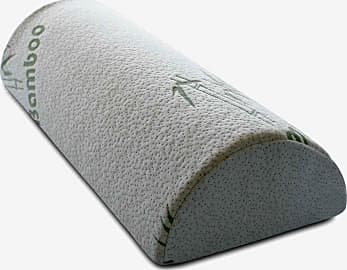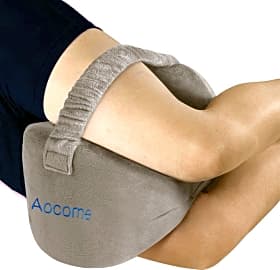The 10 Best Knee Pillows

This wiki has been updated 43 times since it was first published in October of 2015. Whether you use one simply for comfort or you have issues such as sciatica, neck or back pain, arthritis, or scoliosis, one of these leg pillows will help to keep your knees and spine aligned properly to provide welcome relief while sleeping. They come in various sizes and are also particularly well suited for relieving the nighttime discomfort suffered by pregnant women. When users buy our independently chosen editorial recommendations, we may earn commissions to help fund the Wiki.
Editor's Notes
February 12, 2020:
When it comes to a blend of comfort, durability, and affordability, it remains hard to beat the ComfiLife Orthopedic and the Everlasting Comfort. They boast the shape most probably recognize as "standard" for knee pillows, and the latter even has a strap to better keep it in place. We have added the Contour Legacy as a top choice, as well; it is designed a bit differently, made to support more of the thigh than the former options. Whether this is more or less comfortable is largely down to body shape and the amount of support each individual prefers. For those who need even more support, we selected the Back Support Systems Knee-T and the Flippin' Happy Kneed. These may not look like any ergonomic pillows that you're used to, as they are longer than most and have straps to keep them secure between your legs. If they're too long, consider the very simple PalliPartners Pull-On, instead, which keeps your knee bones from rubbing together in the night.
Special Honors
Sleep Number Knee Pillow Thanks to a five-year warranty and a washable cover, you can count on the Sleep Number Knee Pillow to last you for quite a while. Plus, the cover is a handsome gray color that doesn't look as boring or medical as many other plain white options. sleepnumber.com
A Brief History Of The Pillow
The Chinese had their own variations, also made of hard substances like jade, bronze, and bamboo.
The pillow seems like it should be the most natural of inventions. We've been conditioned to look for one every time we go to sleep, so their use seems natural and instinctive. Of course, human history is nothing but an ongoing story of people ignoring the obvious, so pillow usage isn't as natural as you might think.
The first evidence of their use dates back to ancient Egypt, where individuals would lay on headrests made of stone or wood. These pillows had areas carved out for the head and neck, because even if the Egyptians didn't believe in comfort, they did believe in proper support. The Chinese had their own variations, also made of hard substances like jade, bronze, and bamboo. The Chinese had an excuse, though: they believed that harder pillows could keep demons away. Personally, I'd prefer to use a soft cushion, and then take my chances with the demon.
The Greeks and Romans were the first to attempt a cushier alternative. They used straw and reeds, while the richest members of their society were able to afford feather down. Forget philosophy and Hellenistic thought — the down pillow is their greatest contribution to society.
By the 1800s, pillows were commonplace in Western society. Back then, however, the pillowcase was the important thing, as the stuffing had to be changed regularly to prevent mold, mildew, and vermin. I suppose it would be hard to get a good night's sleep with a family of rats nesting in your pillow.
The 20th century brought the mass production of pillows, as well as a diversification of materials and uses. Today we use memory foam, all kinds of down, latex, and various hypoallergenic substances, and rats are rarely a problem. Likewise, pillows are used for more than just comfort, as some help alleviate medical conditions, while others just prevent your bed from looking naked when guests come over.
Tips For Maintaining Correct Posture
You already know you need proper posture, as habitual slouching can cause long-term discomfort for your back, neck, and shoulders.
Before we go any further, however, I have to make the standard admonishment about the importance of maintaining a healthy weight and getting plenty of exercise.
Before we go any further, however, I have to make the standard admonishment about the importance of maintaining a healthy weight and getting plenty of exercise. Extra pounds equal extra stress on your spine, so reaching your goal weight should be your top priority if you suffer from back pain. Likewise, muscular imbalances can cause chronic discomfort, so be sure to work all the muscle groups in your back equally when you hit the gym (chin-ups are especially good for your back).
It's extremely important that you make it easy on yourself to maintain proper alignment. You'll revert to your bad habits as soon as your focus is elsewhere, so find a way to make it easier for you to maintain proper posture. If you sit while working, consider sitting on a yoga ball, which will engage your core, or invest in a high-quality desk chair with proper support. You may even want to switch to a standing or elliptical desk, which can also help you meet your weight loss goals.
Another important thing to remember is that you spend a third of your life in bed, so make sure that you get proper support while you sleep. If you have an old, worn-out mattress, it may be time to upgrade — and don't just go for the cheapest option, if you can help it. This is also where a knee pillow proves essential, as bad posture you reinforce while sleeping can haunt you once you're awake. Conversely, if you use your knee pillow to keep your legs and hips properly in place, it will go a long way towards promoting correct alignment after you get out of bed.
As an added bonus, whenever someone catches you sleeping in, you can just tell them you're working on your posture.
How a Knee Pillow Can Help Fix Common Posture Problems
If you suffer from chronic back pain, the root of the problem may actually lie further down, in your hips. Misalignment of the pelvic girdle can have a wide-ranging impact on the rest of your body, throwing it completely out of whack.
That way, you won't have to compensate for any discomfort when you wake up, and you can start your day with a clean slate, spinally-speaking.
Of course, it's difficult to keep your hips properly calibrated if you twist them like a pretzel every night. If you sleep on your side without a knee pillow, the weight of your top leg will put a strain on your hips and pelvis, slowly twisting them out of their proper positioning. This can start a chain reaction in which your spine, shoulders, and neck are all thrown off-balance.
When you wake up you may not notice that one side of your body has been under duress all night, but the effects can sneak up on you during the day. It can cause you to stand with poor weight distribution, and you may find yourself slouching or sticking your butt out to offset any discomfort that may arise. This just leads to further problems.
A knee pillow can help to better distribute your weight while also reinforcing correct posture. You can augment this by using a neck pillow which keeps your spine straight, so that everything is in proper alignment all night long. That way, you won't have to compensate for any discomfort when you wake up, and you can start your day with a clean slate, spinally-speaking.
Keep in mind that sleep is a chance for your body to reset and recuperate, so you don't want to interfere with that by putting more stress on it. Tucking a pillow between your knees can help you stay comfortable, leading to deeper rest and therefore superior recovery.
While a knee pillow is a cheap and easy way to improve your posture, don't overlook the importance of stretching and exercise. Build up the muscles in your core with planks and bridges, strengthen your back with chin-ups and rows, and never, ever underestimate the importance of stretching your hip flexors.















